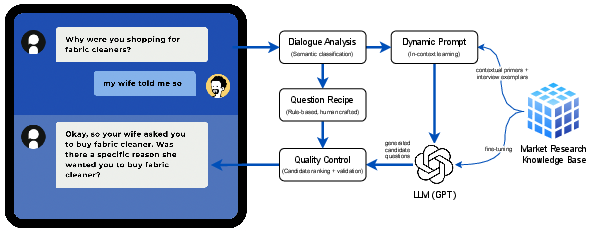- The paper presents SmartProbe’s main contribution: a LLM-driven virtual moderator that generates context-aware probing questions to improve qualitative insights.
- It introduces modules for dynamic prompt engineering and semantic dialogue analysis to ensure high-quality, contextually relevant survey questions.
- The evaluation shows that 69% of SmartProbe-generated questions scored 4/5 or higher, outperforming traditional probing methods in market research.
SmartProbe: A Virtual Moderator for Market Research Surveys
Introduction and Context
"SmartProbe" addresses the need to blend the depth of qualitative research with the scale of quantitative surveys. By leveraging the adaptive capabilities of LLMs, SmartProbe introduces a virtual moderator to market research, enhancing the richness of insights that can be derived from traditional survey methodologies. The primary objective is to generate effective probing questions that mimic the dynamics of human interviewers, thereby eliciting more nuanced responses from survey participants.
System Design and Architecture
The SmartProbe framework is structured into several interconnected modules designed to collectively produce high-quality probing questions.
Dialogue Analysis Module
This module performs semantic analysis and information extraction on the respondent's previous interactions, ensuring that the subsequent probing question is contextually relevant. It employs sentence embeddings for semantic classification, which leads to structured data feeding into the following modules.
Dynamic Prompt and LLM Modules
SmartProbe constructs dynamic prompts tailored to specific survey contexts, utilizing advanced prompt engineering techniques. The LLM module uses models from the InstructGPT family, fine-tuned on a specialized Market Research Knowledge Base, facilitating the generation of candidate probing questions with high relevance and contextual sensitivity.
Question Recipe and Quality Control Modules
The Question Recipe module serves as a fall-back mechanism, curating a bank of template questions that can be deployed in scenarios where LLM output may be suboptimal. The Quality Control module applies heuristics to filter out inappropriate or low-quality questions, ensuring consistency in the moderation process.

Figure 1: Processing flow of SmartProbe, outlining each module's role in generating effective probing questions.
Quality Assessment
An extensive evaluation of SmartProbe's output involved rating 300 probing questions in various market research contexts. The analysis demonstrated that 69% of the generated questions scored 4/5 or higher for quality, indicating a strong alignment with market researchers' expectations.
Comparative Analysis
Further analysis compared the efficacy of SmartProbe-generated questions with traditional, generic probing questions. Surveys conducted revealed a marked improvement in response quality with SmartProbe, with higher proportions of participants providing 4/5 and 5/5 quality responses.
Practical Implications and Future Directions
The implementation of SmartProbe in market research offers significant advancements in obtaining granular consumer insights efficiently. The system's capability to generate contextually relevant questions at scale presents opportunities for industries requiring agile, consumer-led data interpretation. As LLMs evolve, integrating more complex domain-specific knowledge bases could refine SmartProbe's efficacy further. Future endeavors may also explore enhanced personalization features to tailor probing methodologies to individual survey participants.
Conclusion
SmartProbe exemplifies the successful integration of LLM-driven conversational AI within market research, bridging traditional methodologies with modern computational techniques. Its modular architecture and robust evaluation underscore its practical utility for eliciting comprehensive qualitative insights in a scalable, efficient manner. As industries increasingly rely on data-driven decision-making, SmartProbe's contributions to survey methodologies offer a vital tool for more informed strategic planning.


